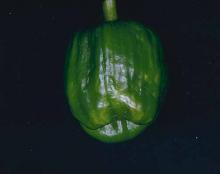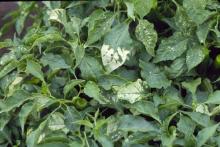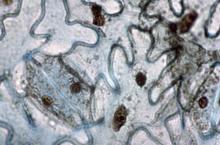Cause Pepper is susceptible to at least 70 different viral pathogens. The more important viruses affecting pepper in the PNW include alfalfa mosaic virus, beet curly top virus, cucumber mosaic virus, pepper mild mottle virus, pepper mottle virus, potato virus Y, tobacco etch virus, and tomato spotted wilt virus. Many of these viruses overwinter in perennial legumes such as alfalfa and various clovers. Several weeds common in the PNW are hosts of some of these viruses.
Alfalfa mosaic virus is spread by aphids and can be seedborne in chili pepper as well as alfalfa; this virus can persist in alfalfa plantings as well as certain weeds and ornamental plants.
Beet curly top virus (BCTV) is vectored by the beet leafhopper and is common in eastern Washington and Oregon as well as occurring in western and southern Oregon; this virus can persist in Russian thistle and sugar beet plantings, among numerous other plant species.
Cucumber mosaic virus (CMV) can be transmitted by aphids and seedborne in pepper. CMV can infect many vegetable crops in additiona to the cucurbits, including carrot, celery, legumes, lettuce, spinach and tomato as well as numerous ornamental flowers and weed species.
Pepper mild mottle virus (PMMV) can cause serious losses and is transmitted by aphids as well as can be seedborne in pepper. Pepper is the primary host for this virus.
Pepper mottle virus (PepMoV) can infect many solanaceous crop and weed species and is transmitted by aphids.
Potato virus Y has a narrow host range but infects the solaneous crops as well as legumes and certain weeds; it is transmitted by aphids.
Tobacco mosaic virus (TMV) is spread by mechanical means and is possibly seedborne in pepper. It can infect a range of solanaceous crop and weed species.
Tomato spotted wilt virus (TSWV) is transmitted by thrips and has an extensive host range of more than 900 crops and weed species.
Symptoms Fruit and pepper plants with virus infections have a diminished fruit set, are stunted, and exhibit discoloration including yellow and green blotches and mosaics as well as leaf distortion and/or lateral leaf rolling. Pepper infected with alfalfa mosaic virus show variable symptoms, depending on the virus strain and environmental conditions but symptoms may include yellow mottling or mosaic and ring-spots on leaves as well as severe leaf necrosis. Plants infected with BCTV early in their development appear stunted and chlorotic; leaves are brittle, yellowish and rolled. Plants infected with CMV exhibit variable symptoms, ranging from a mild to distinct yellow-to-green mottles, ringspots, or line patterns may be on both leaves and fruit. Plants infected with PMMV have only slight foliar symptoms, typically mild yellow-and-green mottling and mosaics as well as chlorosis. Fruit with PMMV can be severely deformed, small in size, and have yellow-or-brown areas on the fruit surface. PepMoV causes a dark-green vein banding, green-and-yellow mottles and mosaics as well as puckered leaves and misshapen fruit; a significant decrease is fruit yield can occur. Potato virus Y causes a mild to severe mottling. TMV causes light-and-dark-green mosaics, brown flecks and blotches, and distortion of leaves; fruit are deformed, small and exhibit light-green, yellowish-to-brown areas on the fruit surface. Plants infected with TSWV may be severely stunted and develop small, black spots on leaves that are roundish or irregular in shape, light-green-or-brown ring spots may occur on leaves while black streaks develop on stems; fruit develop chloritic rings or patches.
Cultural control
- Plant as far as possible from alfalfa and clover fields and permanent pastures containing clover. Also, in the Hermiston, OR area, locate fields away from borders of irrigated agriculture.
- Keep area around fields as weed-free as possible.
- Purchase or plant transplants that are disease- and aphid-free.
- Reduce mechanical spread of the viruses in the field by limiting entry to essential activities.
- Do not smoke and then handle plants before washing hands with soap. This is especially important in greenhouse production.
- Wash hands after handling infected plants.
- Varieties with resistance to TMV are: Yolo-wonder, Pennbell, Bell Boy, California Wonder 300, Orobelle, Bell Tower, Elisa, Marguis, Belle Star, Big Belle, Four Corners, Sweet Belle, Bolero, Lamuyo, Emerald Giant, Prima Belle, Lady Bell, La Bamba, Jupiter, and Keystone Resistant Giant.Hot type varieties resistant to TMV include Anaheim TMR 23, Caloro, Santa Fe Grande, Tam Jalapano, Tam Serrino Hidalgo, and Gold Spike.
Chemical control Aphid control helps but will not perfectly control the viruses they transmit. If tomato spotted wilt is a problem, controlling thrips will be of some help. Controlling leafhoppers will not help control beet curly top. For specific control information, consult the PNW Insect Management Handbook.



